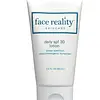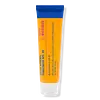What's inside
What's inside
 Key Ingredients
Key Ingredients

 Benefits
Benefits

 Concerns
Concerns

 Ingredients Side-by-side
Ingredients Side-by-side

Ethylhexyl Salicylate 4.75%
UV AbsorberBenzophenone-3 4.25%
UV AbsorberButyl Methoxydibenzoylmethane 3%
UV AbsorberOctocrylene 2.8%
UV AbsorberAcrylates/C12-22 Alkyl Methacrylate Copolymer
Aleurites Moluccanus Seed Oil
Skin ConditioningAllantoin
Skin ConditioningButyloctyl Salicylate
Skin ConditioningBenzoic Acid
MaskingC12-15 Alkyl Benzoate
AntimicrobialCamellia Sinensis Leaf Extract
AntimicrobialCetearyl Alcohol
EmollientCyclopentasiloxane
EmollientDimethicone
EmollientEthylhexylglycerin
Skin ConditioningGlycereth-2 Cocoate
EmulsifyingGlycerin
HumectantHelianthus Annuus Seed Oil
EmollientMacadamia Ternifolia Seed Oil
EmollientMagnesium Aluminum Silicate
AbsorbentPhenoxyethanol
PreservativePolyacrylate Crosspolymer-6
Emulsion StabilisingPotassium Cetyl Phosphate
EmulsifyingTetrasodium EDTA
Tocopheryl Acetate
AntioxidantTocopherol
AntioxidantWater
Skin ConditioningEthylhexyl Salicylate 4.75%, Benzophenone-3 4.25%, Butyl Methoxydibenzoylmethane 3%, Octocrylene 2.8%, Acrylates/C12-22 Alkyl Methacrylate Copolymer, Aleurites Moluccanus Seed Oil, Allantoin, Butyloctyl Salicylate, Benzoic Acid, C12-15 Alkyl Benzoate, Camellia Sinensis Leaf Extract, Cetearyl Alcohol, Cyclopentasiloxane, Dimethicone, Ethylhexylglycerin, Glycereth-2 Cocoate, Glycerin, Helianthus Annuus Seed Oil, Macadamia Ternifolia Seed Oil, Magnesium Aluminum Silicate, Phenoxyethanol, Polyacrylate Crosspolymer-6, Potassium Cetyl Phosphate, Tetrasodium EDTA, Tocopheryl Acetate, Tocopherol, Water
Water
Skin ConditioningZinc Oxide
Cosmetic ColorantCoco-Caprylate
EmollientCaprylic/Capric Triglyceride
MaskingButyloctyl Salicylate
Skin ConditioningPropanediol
SolventVitis Vinifera Seed Oil
EmollientSodium Stearoyl Glutamate
CleansingCetearyl Alcohol
EmollientArachidyl Alcohol
EmollientTocopherol
AntioxidantCaprylyl Glycol
EmollientCoco-Glucoside
CleansingAstrocaryum Tucuma Seed Butter
EmollientEthyl Ferulate
AntioxidantBehenyl Alcohol
EmollientCetyl Palmitate
EmollientSorbitan Palmitate
EmulsifyingSorbitan Olivate
EmulsifyingArachidyl Glucoside
EmulsifyingSodium Gluconate
Skin ConditioningCitric Acid
BufferingBisabolol
MaskingAcacia Senegal Gum
MaskingCaprylhydroxamic Acid
Glycerin
HumectantXanthan Gum
EmulsifyingAcetyl Glucosamine
Skin ConditioningSodium Hyaluronate
HumectantPolyhydroxystearic Acid
EmulsifyingTetrahexyldecyl Ascorbate
AntioxidantAloe Barbadensis Leaf Juice
Skin ConditioningWater, Zinc Oxide, Coco-Caprylate, Caprylic/Capric Triglyceride, Butyloctyl Salicylate, Propanediol, Vitis Vinifera Seed Oil, Sodium Stearoyl Glutamate, Cetearyl Alcohol, Arachidyl Alcohol, Tocopherol, Caprylyl Glycol, Coco-Glucoside, Astrocaryum Tucuma Seed Butter, Ethyl Ferulate, Behenyl Alcohol, Cetyl Palmitate, Sorbitan Palmitate, Sorbitan Olivate, Arachidyl Glucoside, Sodium Gluconate, Citric Acid, Bisabolol, Acacia Senegal Gum, Caprylhydroxamic Acid, Glycerin, Xanthan Gum, Acetyl Glucosamine, Sodium Hyaluronate, Polyhydroxystearic Acid, Tetrahexyldecyl Ascorbate, Aloe Barbadensis Leaf Juice
 Reviews
Reviews

Ingredients Explained
These ingredients are found in both products.
Ingredients higher up in an ingredient list are typically present in a larger amount.
Butyloctyl Salicylate is a chemical UV filter structurally similar to octisalate. It is a photostabilizer, SPF booster, emollient and solvent. This ingredient helps evenly spread out ingredients.
According to a manufacturer, it is suitable for pairing with micro Titanium Dioxide, Zinc Oxide, and pigments.
Photostabilizers help stabilize UV-filters and prevents them from degrading quickly.
Learn more about Butyloctyl SalicylateCetearyl alcohol is a mixture of two fatty alcohols: cetyl alcohol and stearyl alcohol. It is mainly used as an emulsifier. Emulsifiers help prevent the separation of oils and products. Due to its composition, it can also be used to thicken a product or help create foam.
Cetearyl alcohol is an emollient. Emollients help soothe and hydrate the skin by trapping moisture.
Studies show Cetearyl alcohol is non-toxic and non-irritating. The FDA allows products labeled "alcohol-free" to have fatty alcohols.
This ingredient is usually derived from plant oils such as palm, vegetable, or coconut oils. There is debate on whether this ingredient will cause acne.
Due to the fatty acid base, this ingredient may not be Malassezia folliculitis safe.
Learn more about Cetearyl AlcoholGlycerin is already naturally found in your skin. It helps moisturize and protect your skin.
A study from 2016 found glycerin to be more effective as a humectant than AHAs and hyaluronic acid.
As a humectant, it helps the skin stay hydrated by pulling moisture to your skin. The low molecular weight of glycerin allows it to pull moisture into the deeper layers of your skin.
Hydrated skin improves your skin barrier; Your skin barrier helps protect against irritants and bacteria.
Glycerin has also been found to have antimicrobial and antiviral properties. Due to these properties, glycerin is often used in wound and burn treatments.
In cosmetics, glycerin is usually derived from plants such as soybean or palm. However, it can also be sourced from animals, such as tallow or animal fat.
This ingredient is organic, colorless, odorless, and non-toxic.
Glycerin is the name for this ingredient in American English. British English uses Glycerol/Glycerine.
Learn more about GlycerinTocopherol (also known as Vitamin E) is a common antioxidant used to help protect the skin from free-radicals and strengthen the skin barrier. It's also fat soluble - this means our skin is great at absorbing it.
Vitamin E also helps keep your natural skin lipids healthy. Your lipid skin barrier naturally consists of lipids, ceramides, and fatty acids. Vitamin E offers extra protection for your skin’s lipid barrier, keeping your skin healthy and nourished.
Another benefit is a bit of UV protection. Vitamin E helps reduce the damage caused by UVB rays. (It should not replace your sunscreen). Combining it with Vitamin C can decrease sunburned cells and hyperpigmentation after UV exposure.
You might have noticed Vitamin E + C often paired together. This is because it is great at stabilizing Vitamin C. Using the two together helps increase the effectiveness of both ingredients.
There are often claims that Vitamin E can reduce/prevent scarring, but these claims haven't been confirmed by scientific research.
Learn more about TocopherolWater. It's the most common cosmetic ingredient of all. You'll usually see it at the top of ingredient lists, meaning that it makes up the largest part of the product.
So why is it so popular? Water most often acts as a solvent - this means that it helps dissolve other ingredients into the formulation.
You'll also recognize water as that liquid we all need to stay alive. If you see this, drink a glass of water. Stay hydrated!
Learn more about Water